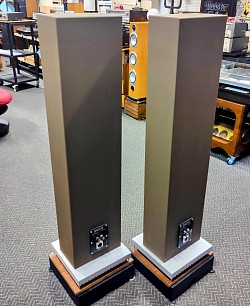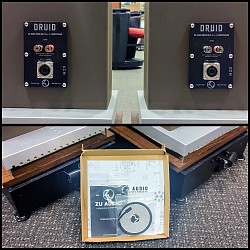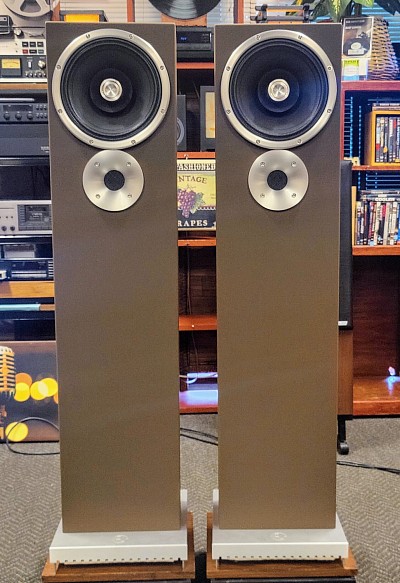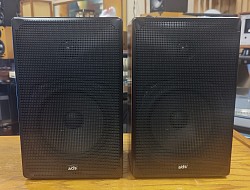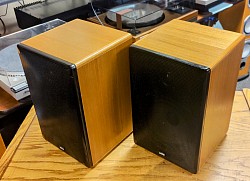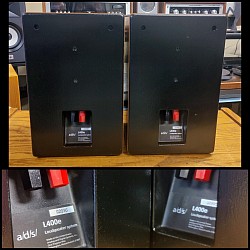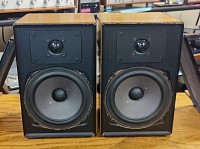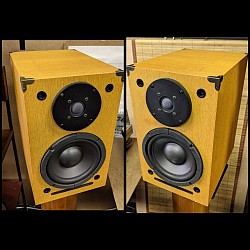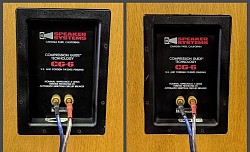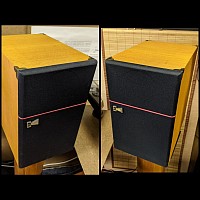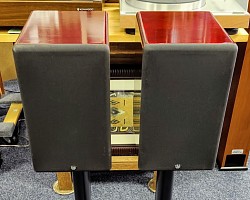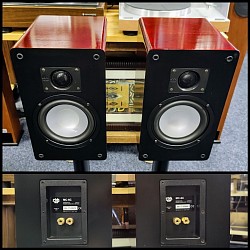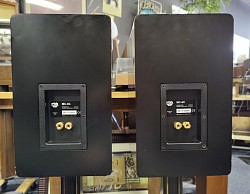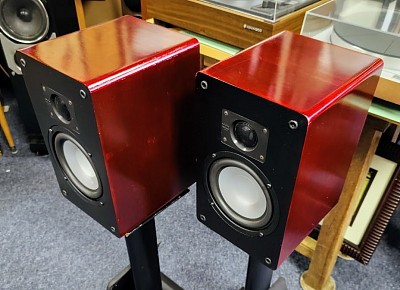Page 3 Stereo Speaker Systems
Zu Audio Druid V
('12-'14) $3000 (perfect)
Obtained locally from the original owner, this pair of Zu Audio Druid V speakers are in absolutely perfect cosmetic and operating condition. For those unfamiliar with the Utah-based company, Zu Audio's products appear "other worldly" at first glance. They are reminiscent of the monolith cuboid in "2001: A space Odyssey".
The Druid V is a high efficiency, high-output, 16 ohm floor-standing loudspeaker. They are incredibly efficient; rated at 101 dB and they are heavy at about 80 lbs each. They are also tall at 50" and narrow at 11.5" wide and 7" deep with a footprint of 12.75". They are approximately 70% broken in; this particular pair has a custom-ordered finish called "Matte HM Brown" ($2500 extra), the actual cost of this pair of speakers was $8000 new.
(NOTE: The black base shown in the photos is for showroom use only, they allow us to move the speakers around for demo purposes.)
According to Zu, the Druid was "designed to perform without having to use tone-robbing crossover or filter elements; is complete with full implementation of ZuGriewe driver/box/room acoustic loading technology; and shares the same tweeter driver as their Dominance and Definition Mk.IV speakers (like the sensational Radian 850) which not only provides the treble resolution and sparkle from 8kHz and up, but takes advantage of its ten pounds of mass and eight inches of diameter to operate as a stressed member of the cabinet, significantly improving baffle damping, strength and system performance."
Key points about the Zu Audio Druid V:
~Full-range driver: The Druid V utilizes a 10-inch full-range driver, the Zu 260FRD/ND-12, which contributes to its unique sound characteristics.
~Zu-Griewe acoustic loading technology: This proprietary design is a key element of the Druid V's construction, influencing its soundstage and bass response.
~Hand-built in the USA: Zu Audio is known for building its speakers by hand in the United States. It should be mentioned that Zu Audio claimed the life expectancy of the Druid V is at least "100 years including parts".
NOTE: We like their sense of humor.
Reviews:
"If you are looking for downright fun — and dare I say it, excitement — in a modern, cool-looking package that grabs the imagination, then step right up. If you are looking for jump-out-of-your-skin dynamics and the ability to accelerate like an F-16, then you’ve come to the right place.
Yes, these Zu speakers are about excitement and enjoyment. ~PT Audio
"It (Druid V) has excellent bottom-to-top spectral uniformity and dynamic behaviour without a bunch of electrical damping which (our) speakers really don't benefit from."
~6 Moons Audio
https://6moons.com/audioreviews2/zu2/2.html
"Audiophiliac speaker of the year: Zu Druid V...this skinny tower comes out of Utah, and looks and sounds a lot more expensive than it is." ~CNET
About Zu Audio...
https://www.zuaudio.com/philosophy
+++++++++++++++++++++++++++++++++++++++++++++
+++++++++++++++++++++++++++++++++++++++++++++
A/D/S L400E
(early 90's) $300
In excellent cosmetic condition, completely original and perfectly operational, this pair of A/D/S L400e were first released in 1992. They were introduced as the last version of their highly regarded L400 series and called it the L400E.
These are the end-state (smaller version) of the largest model of the classic a/d/s/ mini-monitor line. They feature 1" co-polymer dome tweeters and 6.5" "Stifflite" woofers and steep crossover slopes. On the rear are excellent five-way binding posts. Essentially, the A/D/S L400E are best described as studio mini monitors.
They do that trick that mini-monitors do, with very focused imaging and a sweet but accurate mid-band. These speakers have a particularly "nice" sounding tweeter, with a little dip around 4k and a little peak around 13k resulting in a "sparkly" sound, very accurate and very musical.
The A/D/S L400 series was originally designed by Dieter Rams, a highly respected audio engineer. Probably the biggest reason to seek out these models today is because they are simply beautiful. The solid-walnut enclosures with the radius edges match the very expensive styling of the Danish dressers and nightstands of the same era, referred to as Danish "Komfort" designed furniture. The wood covers the entire sealed-metal box construction. As with all of the later versions of ADS models, they feature the perforated black metal grills.
Specs:
Frequency response: 60-20,000 Hz ± 3 dB.
Sensitivity: 88 dB SPL
Power: 35 watts minimum
Crossover: 2 kHz
Dimensions: 12"H x 7.5"W x 7.5"D
Weight: 9.5 lbs each
Original MSRP: $600/pair
About A/D/S/Braun...
As best as can be learned from varied details, A/D/S (Analog & Digital Systems) was the American importer's company label. Braun was the original German company which built the raw drivers and to some extent had a small, popular line of (fairly conventional) Braun speakers, tape decks and amplifiers for sale in Europe. The most common link to the A/D/S/Braun line was a Dr. Gunther who wished to import the products and traveled around to dealers trying to stir interest in the late '70's when Germany was not yet on the US audiophile map beyond Dual (from the Black Forest area) and a by then less well known Blaupunkt. (Studer and Revox were both Swiss companies distributed originally through German lines.)
Eventually, enough dealers signed on to a commitment and Gunther established A/D/S as the "manufacturer" of the speakers in the US. This was fair at the time as many companies were using drivers sourced from various manufacturers around the world and subsequently designing and building their own systems with either off the shelf drivers or custom modified drivers from a larger company.
At A/D/S, Gunther hired a designer (some say it was Michael Kelly) to build finished speakers around the Braun drivers. Another company built cabinets here in the US to A/D/S' specifications. Kelly managed some fairly industrious and unique designs for A/D/S which drew significant attention to the A/D/S line. As the A/D/S line grew in stature and sales, Braun took notice and thought they could do just as well or better under their own name by trading on the popularity, reputation and success of the A/D/S line. The problems started with the issue of Braun having to import entire speaker systems which meant fairly heavy cabinets were being shipped across the sea incurring added expense not seen in the A/D/S line who had only been shipping raw drivers. A/D/S and Braun existed for a time as distinct lines with only passing similarities yet in discrete dealerships which led to many conflicts of interest and many awkward questions for everyone concerned. Braun's answer to this pricing issue was to cut off A/D/S's access to many of their most successful drivers. Suddenly A/D/S was in danger of being put out of business without a product line along with not having any backup drivers for repairs. Promises to dealers were being broken on a daily schedule as both revenues and resources dried up. Many of Kelly's designs were difficult to drive and required high power yet the Braun drivers were not meant for high power handling. This led to numerous repairs being done by dealers. Day by day, many dealer's repair facilities were stacking full of broken A/D/S speakers waiting for parts that never came.
There was a short compromise where A/D/S/Braun speakers existed as one line but Braun soon found themselves under commitment to repair existing A/D/S/Kelly designed speakers while not having the benefit of using all of Kelly's designs - many of which Braun disapproved of due to their reliability issues and their not being "perfect" examples of Braun design skills (which were not of the type desired by the average US audiophile of the day).
New dealers had been established for the A/D/S/Braun line separate from the original A/D/S and Braun dealerships, many original A/D/S dealers were left out in the cold without any factory backup and new Braun dealers were expected to use their own resources to fulfill A/D/S's commitments to parts and service. Court battles quickly and seemingly endlessly ensued. Eventually A/D/S was subsumed and then ceased to exist as a distinct company. Braun speakers went on in the US for a few years without most of the innovation of the A/D/S/Kelly designs and eventually faded ingloriously from the US market. Memories from customers ranging from fond to highly upset and generally hard feelings from dealers who stuck it out too long or hoped to make a quick buck off someone else's efforts were all that were left...
++++++++++++++++++++++++++++++++++++++++
++++++++++++++++++++++++++++++++++++++++
RSL RogerSound Labs CG-6
Compression Guide (1991) $400
In excellent cosmetic and operating condition, this pair RSL CG6 speakers are rarely seen on the East Coast. These are a 2-way studio monitor system internally wired with monster cable. The CG-6 was first introduced in 1991 and was manufactured through an alliance between RSL and Klipsch until 1992.
The beautiful oak cabinets have RSL's "red line" distinctive grills and unique brass badges; a knuckle rap on the enclosures reveals the very solid, heavily braced construction. They weigh 20 lbs each.
If you look at the cutaway view in the photo above you can see how the narrow horizontal front-facing ports allow the CG-6 to pump out an impressive amount of air that eventually winds its way through the interior maze design referred to as the "compression guide" technology.
While no longer in production, CG-6 speakers are still owned and listened to by RSL fans around the world as part of two-channel audio and/or home theater surround sound systems.
Rogers used their proprietary Compression Guide (CG) technology as they recognized that resonance inside a speaker enclosure can create havoc for your ears. The compression guide system is kind of like a cattle shoot for air within the speakers. Air will travel throughout the speaker enclosure from areas of high compression to areas of low compression in an attempt to prevent internal resonances from mucking up what the woofers and tweeters are trying to accomplish. Rather than just letting the air bounce around inside the cabinet until it’s worn itself out or escaped through the port (in vented styles), CG directs the air along a calculated route. The purpose is to create very clean, accurate sounding speakers.
Specs:
Frequency response: 50 Hz to 22 kHz (±2.5dB)
Impedance:4 ohms
Tweeters 1"
Woofers: 6.5"
Dimensions: 8 3/4"W x 14"H x 11 1/2"D
Weight: 20 lbs. 8 oz. each
Finish: light oak
About RogerSound Labs (RSL)...
In the ‘70s and ‘80s Howard Rodgers owned a series of hi-fi stores in Southern California called Rogersound Labs. He was (and still is) an icon in the San Fernando Valley, CA who had built himself a reputation for manufacturing the highest quality speakers possible for the money. They sold direct to the consumer to avoid high retail markups and put most of the savings back into the quality of their builds. In the 80's, RSL Speakers were industry-standard in many recording studios throughout Southern California. Howard started off in a small shop in North Hollywood, building speakers one at a time by hand. He later moved the business to a larger facility in Canoga Park where he really gave JBL a run for their money.
++++++++++++++++++++++++++++++++++++++++
++++++++++++++++++++++++++++++++++++++++
RBH Sound MC-6C
(1998) $325
In very good cosmetic condition and fully operational, this pair of excellent RBH MC-6C speakers were the first series of this model and are best described as 2-way, 8-ohm, direct-radiating designs. The enclosures are finished in a luxurious mahogany laminate with black cloth on the grills and high quality binding posts.
At the heart of the MC-6C is a 6.5" proprietary aluminum conebass/midrange driver. This unique aluminum cone material combines stiffness, low mass and self damping properties in a manner which allows virtually uncolored presentation of program material. A powerful magnet,extended voice coil and bumped back plate give the bass/midrange driver high excursion capability, which allows accurate dynamic reproduction.
For the highs they developed a proprietary 1" aluminum dome tweeter with liquid cooling to allow greater power while retaining detail and accuracy.The use of steep crossover slopes allows high power handling, minimizes driver interaction anomalies, and maximizes the clarity with which each driver is able to produce its respective frequency band. A poly switch, or current limiting device, is used in the crossover to prevent damage to the tweeter if overdriven.
The mahogany laminate cabinets are constructed of ¾" medium density fiberboard due to its inert properties, thereby preventing sound coloration due to cabinet diffraction. The thickness of the front baffles also prevents excess acoustic radiation. Large oversized gold binding posts ensure a good electrical contact. Sophisticated computer modeling and measurement techniques were used extensively in the MC-6C design process.
For the technically curious, here are the rated specs:
On-axis response of the MC-6C surround measures +2.5/-4.0 dB from 200 Hz to 20 kHz.
~The -3dB point is at 61 Hz, and the -6dB point is at 51 Hz.
~Impedance reaches a minimum of 7.8 ohms at 221 Hz and a phase angle of -51.3 degrees at 82 Hz.
Sensitivity is 87 dB from 500 Hz to 2 kHz.
Dimensions: 8"W 13.5"H 9.5"D
Weight: 24 lbs each
About RBH Sound...
RBH Sound, founded in 1976, is a manufacturer of high performance audio products for residential and commercial applications. Their initial business model was that of an OEM manufacturer.
RBH Sound provided speakers to some well known manufacturers in the residential and commercial market, these included McIntosh, Fosgate, Parasound and JBL. In addition to providing the finished product to these companies, RBH Sound also provided audio engineering and consulting services.
In 1986, the company’s business plan changed. The company relocated to Utah and the primary focus shifted from OEM relationships to building brand recognition for the RBH Sound name.
++++++++++++++++++++++++++++++++++++++++++
++++++++++++++++++++++++++++++++++++++++++
B&W DM-601
('96-'99) $300
In very good cosmetic condition, completely original and fully operational, this pair of B&W DM-601 speakers are a testament to the fact that B&W never made a pair of speakers that didn't sound great! Not too big, not too small, the DM-601 are a perfect sized bookshelf speaker that are easy to drive with their 8 ohm impedance.
The DM 601 is the smallest in the 600 Series although it can still produce a big sound. It has a 6.5" *Kevlar bass/mid-range driver that employs the same profile as B&W's more sophisticated P-Series ensuring delivery of a natural, neutral sound with very low coloration.
As well as the 600 Series standard features, the DM-601 also boasts flared reflex ports which dramatically increase bass efficiency and power handling. Added to this is rounded profile zinc clamping rings which connect the drivers to the cabinet and minimize the effect of diffraction around the drive unit as sound waves travel out across the face of the speaker cabinet.
They are recommended for shelf or stand mounted applications and is ideally suited to both front and rear channel speakers in a Home Cinema system.
Specs:
Drive units: 25mm metal dome tweeter & 165 mm Kevlar® cone bass /mid
Frequency response: 70Hz – 20kHzSensitivity: 88 dB
Nominal impedance: 8 ohms
Power handling: 25-100 watts into 8 ohms
Dimensions: 14"H x 8"D x 7"W
*Kevlar®: B&W developed and patented the method of using Kevlar® for loudspeaker cones to reduce unwanted standing waves. DuPont originally created Kevlar® for use in bulletproof vests.
About Bowers & Wilkins...
The sleepy coastal town of Worthing in South England might not look like a hotbed of 1960s freewheeling experimentation, but for audio fans it’s a place that’s synonymous with innovation. Thanks to the first Bowers & Wilkins speakers built there in the early years of the company, music lovers could experience albums such as Sgt. Pepper and Pet Sounds in new, mind-expanding depth and clarity.
In 1966, John Bowers set up his company with his partner Roy Wilkins and began assembling speaker systems in the workshop of their electronics shop and designed their first speaker, the P1. The profits from this beginning allowed them to invest in new calibration equipment. By 1968, the high quality "Domestic Monitors" (DM1, DM3) brought more recognition from the audiophile community.In the 70's, with John Bowers at the head of the company, things really took off...with the development of curved cabinet forms and the use of new cone materials such as Kevlar, they hit it big with the Model 801 which almost immediately became the reference speaker of choice for many of the world's leading recording studios.
Also, the first model DM6 from acclaimed designer Sir Kenneth-Grange appeared in 1976. The later DM7 was the first that featured the iconic "tweeter-on-top" that's still used today.In the 90's the appearance of the (now very famous) B&W "Nautilus" which totally upended the preconceived notions of speaker design.Even though John Bowers passed away in 1987, today, in the so-called digital age, B&W just keeps moving along with its latest versions of the Diamond Series and so much more.
+++++++++++++++++++++++++++++++++++++++++++++++
+++++++++++++++++++++++++++++++++++++++++++++++

